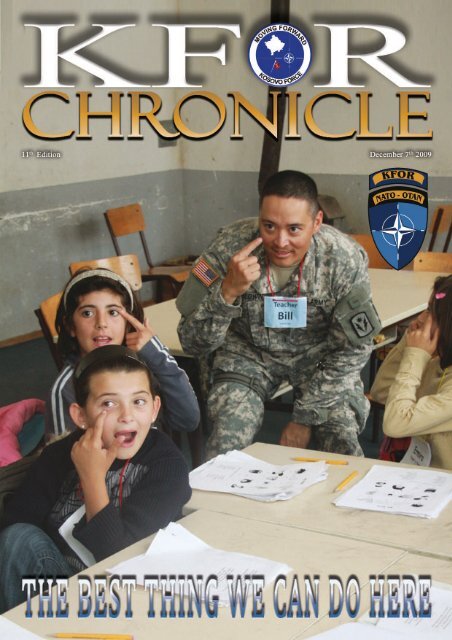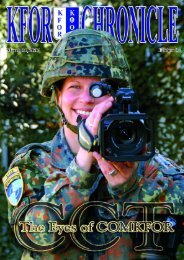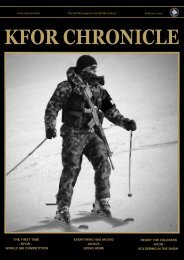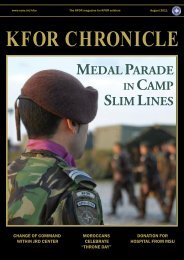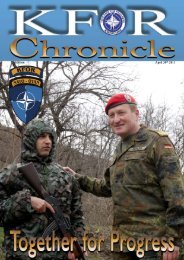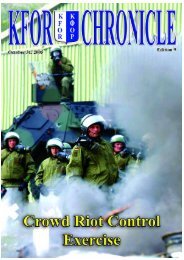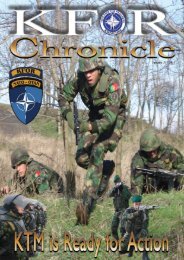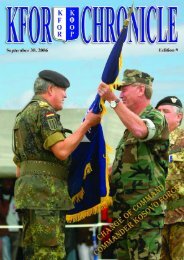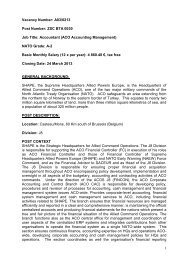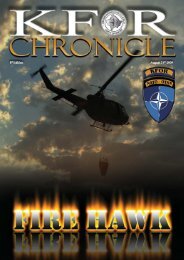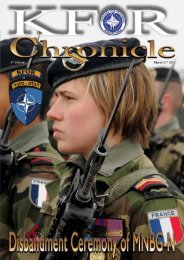2009-11_KFOR_Chronicle_final:Layout 1.qxd - ACO - NATO
2009-11_KFOR_Chronicle_final:Layout 1.qxd - ACO - NATO
2009-11_KFOR_Chronicle_final:Layout 1.qxd - ACO - NATO
You also want an ePaper? Increase the reach of your titles
YUMPU automatically turns print PDFs into web optimized ePapers that Google loves.
On 7 August <strong>2009</strong>, <strong>KFOR</strong> achieved a historical milestone when<br />
we transitioned from Focused Engagement to Deterrent<br />
Presence. During this critical phase of operations, the Operations<br />
Division would like to emphasize how Deterrent Presence will<br />
affect the <strong>KFOR</strong> soldiers on the ground and what should be<br />
expected of them. It is important to emphasize to all soldiers<br />
from all Task Forces how their actions can be decisive for the<br />
success of <strong>KFOR</strong>.<br />
The main challenge of Deterrent Presence will be the significant<br />
adaptation of our force structure which keeps our core<br />
capabilities intact while reducing the number of forces and<br />
maintaining the same level of the Safe and Secure Environment<br />
(SASE) throughout Kosovo. Deterrent Presence is the most<br />
ambitious phase for <strong>KFOR</strong> since 1999 due to the necessity of<br />
coordinating the activities of all stakeholders including our<br />
international partners, the Institutions in Kosovo and the local<br />
civilian populace. Each officer, NCO and soldier from the Task<br />
Forces and Film City HQ are critical components to achieve the<br />
desired goals and wishes of our nations represented in SHAPE.<br />
Over the upcoming months, the Task Forces and then the BGs<br />
will participate in a number of joint exercises and operations<br />
throughout the <strong>KFOR</strong> AOR. The goal of the joints exercises will<br />
be to enhance cooperation between EULEX and Kosovo Police. This ability will become increasingly important as<br />
<strong>KFOR</strong> continues its progressive process of unfixing troops. Additionally, <strong>KFOR</strong> personnel can expect to participate in<br />
Crowd and Riot Control (CRC) exercises which could involve Tactical Reserves (TACRES) in order to preserve our<br />
capacity to intervene against any threat jeopardizing the SASE.<br />
<strong>KFOR</strong> soldiers would expect to receive some comrades from the Operational reserve Force (ORF) deployed for a<br />
training period IOT enhance <strong>KFOR</strong> determination and capacity to reinforce our layout whenever and wherever required<br />
under COM<strong>KFOR</strong> authority.<br />
High visibility visits can be expected in order to highlight the many <strong>KFOR</strong> accomplishments in Kosovo. These VIP<br />
visits are essentials in supporting COM <strong>KFOR</strong>’s goal of obtaining approval from the Northern Atlantic Council (NAC)<br />
to begin transition through the Deterrent Presence process and to move forward.<br />
Success in Deterrent Presence will depend on the cohesion and the will of a team - a team built from 10 years of hard<br />
work in difficult conditions - Team <strong>KFOR</strong>. It is only through this team’s<br />
determination and professionalism that <strong>KFOR</strong> can hope to fuse the efforts<br />
of our international partners to achieve success in Deterrent Presence.<br />
Brigadier General Leonard Philippe<br />
French Army<br />
Deputy Chief of Staff Operations<br />
2<br />
<strong>KFOR</strong> <strong>Chronicle</strong>, November, <strong>2009</strong>
When you read these lines, in many <strong>KFOR</strong> nations, people have started the time<br />
of Advent, a time of reflection and a time of preparation for Christmas. For many<br />
it is a wonderful time of the year – family reunion is in sight, delicious food is<br />
being cooked and candles are being placed on Christmas trees as a symbol for the<br />
light of life that is about to come and join our common human lot.<br />
Soldiers in particular are aware of the costs of their duty when they are away from<br />
their beloved ones during this special time of the year. They agree to<br />
inconvenience, to discipline and to abdication while others fully enjoy their life.<br />
Though, each person’s life being secured, each day without violence is worth the<br />
mission to Kosovo. Peace in general is a sign for what Christmas is about.<br />
Constructive deeds and a faithful heart are not contradictory, not in the Christian,<br />
not the Muslim nor in any other faith.<br />
In this respect it is time to say that <strong>NATO</strong>’s mission to Kosovo really is a success!<br />
Based on the personal attendance of men and women from all <strong>KFOR</strong> nations, based<br />
on the conviction of different societies and their parliaments, the will to peace is<br />
being conducted and has succeeded where violence and ethnic denegation<br />
devastated the region ten years prior. Not only the people of Kosovo have benefited<br />
from the <strong>KFOR</strong> but also the participating nations and their soldiers. The great<br />
experience has a lot to do with Advent: the mutual effort and decisiveness of the<br />
many and the different have led to peace and improvement of living conditions for<br />
the people of Kosovo.<br />
A shared vision for life has been the basis for peaceful development. In the<br />
Villaggio Italia, every visitor is welcomed by a deep and challenging truth. Written<br />
on a wall we read: pace per l’unita. Peace will grow by unity.<br />
Obviously, for our mission, it was essential to focus on uniting beliefs, and interests<br />
for a common benefit. Unity is hard-earned and not always pleasant. It challenges<br />
the individual and the many by the need for compromise. Hoverver it’s worth it.<br />
Peace is worth it, wiped-off tears are worth it, physical and mental integrity of<br />
human beings are worth it.<br />
Every single beam from the light of life, that shines on us is worth it.<br />
May you and your families and the people we commonly serve experience a<br />
comforting, encouraging time of Advent! May peace grow by the common<br />
decisiveness to unity!<br />
Military Dean Peter Schmidt<br />
Coordinating Chaplain <strong>KFOR</strong><br />
Peter Schmidt serves as<br />
Coordinating Chaplain <strong>KFOR</strong><br />
(DEU) since Sept. 10th <strong>2009</strong>.<br />
Ordained in 1992 he worked in<br />
the USA and for different<br />
churches in Germany. His<br />
emphasis has been on pastoral<br />
care, worship services and<br />
conduct. Since 2007 he is head<br />
of the department of protestant<br />
military chaplaincy in Bonn at<br />
the first site of the Ministry of<br />
Defense. He is married to<br />
Verena Schmidt-Wittmann,<br />
professional violinist and<br />
singer. They have to sons,<br />
David (12) and Valentin (9).<br />
Commander <strong>KFOR</strong><br />
Lt. Gen. Markus Bentler, DEU Army<br />
Chief Public Affairs Office<br />
Col. Manfred Wittig, DEU Air Force<br />
Chief Internal Infomation & Editor<br />
Maj. Andreas Brückner, AUT Army<br />
Contributing Editor<br />
Captain Martin Wieland, AUT Army<br />
Journalist<br />
Lt. Col. Serhiy Panchenko, UKR Ar my<br />
Webmaster<br />
OR-5 Mejia Ezrick, U.S. Air Force<br />
Photographer and Design<br />
Mr. Afrim Hajrullahu<br />
E-mail & web:<br />
kforchronicle@hq.kfor.nato.int<br />
www.nato.int/kfor<br />
The <strong>KFOR</strong> <strong>Chronicle</strong> is produced and fully<br />
funded by HQ <strong>KFOR</strong>. It is published for <strong>KFOR</strong><br />
forces in the area of responsibility.<br />
The contents are not necessarily the official<br />
views of, or endorsed by, the coalition<br />
governments’ defense departments.<br />
Editorial content is edited, prepared and<br />
provided by the Internal Information Section<br />
of HQ <strong>KFOR</strong>’s Public Affairs Office<br />
(PAO) in Pristina, Kosovo.<br />
PAO HQ <strong>KFOR</strong><br />
reserves the right to edit content to<br />
conform to style and space requirements.<br />
Articles run on a space-available basis.<br />
The <strong>KFOR</strong> <strong>Chronicle</strong> is<br />
printed by RASTER<br />
Tel: 038 601 606<br />
Nations within <strong>KFOR</strong>:<br />
<strong>NATO</strong> Nations<br />
Belgium<br />
Bulgaria<br />
Canada<br />
Croatia<br />
Czech Republic<br />
Denmark<br />
Estonia<br />
France<br />
Germany<br />
Greece<br />
Hungary<br />
Italy<br />
Armenia<br />
Austria<br />
Finland<br />
Ireland<br />
Lithuania<br />
Luxembourg<br />
Netherlands<br />
Norway<br />
Poland<br />
Portugal<br />
Romania<br />
Slovakia<br />
Slovenia<br />
Turkey<br />
United Kingdom<br />
United States<br />
Non-<strong>NATO</strong> Nations<br />
Morocco<br />
Sweden<br />
Switzerland<br />
Ukraine<br />
<strong>KFOR</strong> <strong>Chronicle</strong>, November, <strong>2009</strong> 3
Photos by OR-5 Stefanie Willuweit, German Army, and OR-4 Maxime Phaine, French Army<br />
November 05, <strong>2009</strong><br />
COM <strong>KFOR</strong>, Lieutenant General Markus Bentler, greeted<br />
the Catholic Bishop of the Federal Armed Forces of<br />
Germany, Walter Mixa. During the meeting issues<br />
concerning religious situations in Kosovo were discussed.<br />
November 05, <strong>2009</strong><br />
The Kosovo Force Commander welcomed President of the<br />
Assembly, of the Islamic Community of Kosovo, Xhabir<br />
Hamiti. During the meeting both sides discussed issues of<br />
tolerance between all the religious communities of Kosovo.<br />
November 05, <strong>2009</strong><br />
Lieutenant General Markus Bentler greeted Deputy<br />
Commander-in-Chief of the Ukrainian Land Forces,<br />
Lieutenant General Anatoly Pushniakov. Lieutenant<br />
General Anatoly Pushniakov discussed the current<br />
situation in Kosovo and issues relating to Ukraine’s<br />
contribution in <strong>KFOR</strong>.<br />
November 10, <strong>2009</strong><br />
Commander Joint Forces Command Naples, Admiral Mark<br />
Fitzgerald discussed the update of the security situation with<br />
COM <strong>KFOR</strong>, Lieutenant General Markus Bentler, during<br />
his inspection to the Multinational Task Force North.<br />
4<br />
<strong>KFOR</strong> <strong>Chronicle</strong>, November, <strong>2009</strong>
November 10, <strong>2009</strong><br />
Lieutenant General Markus Bentler invited a delegation<br />
of representatives of leading international organizations<br />
in Kosovo. With Head of Mission International Civilian<br />
Office/European Union Special Representative Mr. Pieter<br />
Feith, Special Representative, to the United Nations<br />
Secretary General, Mr. Lamberto Zannier, Head of<br />
Mission EULEX, Mr. Yves de Kermabon and Head of<br />
Mission OSCE Mr. Werner Almhofer, discussed the issues<br />
concerning cooperation with local law enforcement<br />
organizations.<br />
November 12, <strong>2009</strong><br />
COM <strong>KFOR</strong> welcomed Turkish Military Representative<br />
to Supreme Headquarters Allied Powers Europe, Major<br />
General Atilla Gϋrdere. During the meeting, Lieutenant<br />
General Markus Bentler explained the event-driven<br />
transition process to and through the future force<br />
reduction.<br />
November 12, <strong>2009</strong><br />
Lieutenant General Markus Bentler, welcomed <strong>NATO</strong><br />
Assistant Secretary General Defense Policy and Planning,<br />
Mr. Jiri Sedivy. During the office call, he discussed the<br />
current situation in <strong>KFOR</strong> Area of Responsibility with<br />
COM <strong>KFOR</strong>.<br />
November 25, <strong>2009</strong><br />
November 25, <strong>2009</strong><br />
The former Austrian Ambassador to Kosovo, Dr. Albert<br />
Rohan, was invited to an office call with Lieutenant<br />
General Markus Bentler. They discussed the current<br />
political situation in Kosovo.<br />
The day before, Ambassador Dr. Albert Rohan was<br />
awarded the highest distinction of Kosovo by President<br />
Fatmir Sejdiu for his particular engagement as a UN-<br />
Negotiator and for the preparation of an solution proposal<br />
for the status of Kosovo. In addition he was given the title<br />
“Doctor honoris causa” of the University of Pristina.<br />
<strong>KFOR</strong> <strong>Chronicle</strong>, November, <strong>2009</strong> 5
Story and photos by Specialist Chris Erickson, U.S. Army<br />
Multi-National Task Force – East is a U.S. led task force. The Headquarters<br />
is the 141st Maneuver Enhancement Brigade from North Dakota. MNTF-<br />
E includes nearly 2.200 soldiers, including Task Force Hellas and Task<br />
Force POL/UKR (Polish/Ukraine). The charter mission of MNTF-E is<br />
maintaining a Safe and Secure Environment and providing Freedom of<br />
Movement for the people in Kosovo.<br />
On 14 November <strong>2009</strong>, a new U.S. led Kosovo Forces (<strong>KFOR</strong>) task force<br />
officially took over responsibility of Multi-National Task Force - East<br />
(MNTF-E), during a Transfer of Authority ceremony at Camp Bondsteel,<br />
Kosovo.<br />
At the mid-day event, incoming commander Brig. Gen. Alan S. Dohrmann,<br />
141st Maneuver Enhancement Brigade, of the North Dakota National<br />
Guard, assumed command of MNTF-E from Brig. Gen. Keith D. Jones,<br />
40th Infantry Division of the California National Guard.<br />
Brig. Gen. Jones and his soldiers have been maintaining safety and security<br />
in Kosovo since they arrived in February of <strong>2009</strong>. Brig. Gen. Dohrmann<br />
said he looks forward to continuing that important mission with the help of<br />
multi-national partners from Task Force Hellas (Greece) and Task Force<br />
6<br />
<strong>KFOR</strong> <strong>Chronicle</strong>, November, <strong>2009</strong>
POL/UKR (Poland and the Ukraine), as well as units<br />
from Armenia and Romania.<br />
“For me to complete my mission, and to continue on<br />
the path to a brighter future, we – the international<br />
community, Non-Governmental Organization, the<br />
Institutions in Kosovo, Municipal leaders, Religious<br />
leaders, other formal and informal leaders, and, most<br />
importantly, the people in Kosovo – must work<br />
together as a team to build the brighter future that we<br />
all want for our children – wherever we call home,”<br />
Brig. Gen. Dohrmann said.<br />
The incoming soldiers, under Dohrmann’s command,<br />
started arriving in Kosovo late October.<br />
Brig. Gen. Dohrmann and Jones were joined at the<br />
event by <strong>KFOR</strong> commander Lt. Gen. Markus Bentler,<br />
the Adjutants General of North Dakota and<br />
California, Maj. Gen. David A. Sprynczynatyk and<br />
Maj. Gen. William H. Wade II, respectively.<br />
A large number of special guests of MNTF-E also<br />
were in attendance for the ceremony.<br />
Brig. Gen. Dohrmann previously served as<br />
Deputy Adjutant General and Land<br />
Component Commander of the North Dakota<br />
Army National Guard. This is his second<br />
deployment to Kosovo, having been<br />
Command Judge Advocate for<br />
MNTF-E forces in 2004 - 2005.<br />
“Progress is being made in<br />
Kosovo,” Brig. Gen. Dohrmann<br />
said. “Since I was last here in<br />
2005, I have seen remarkable<br />
improvements in Kosovo. From<br />
new construction and improved<br />
infrastructure, to multi-ethnic<br />
youth events and religious<br />
leader meetings, Kosovo is<br />
headed toward a brighter future.”<br />
<strong>KFOR</strong> <strong>Chronicle</strong>, November, <strong>2009</strong> 7
Story by OR-8 András Farkas, Hungarian Army<br />
Photos by Lieutenant Melinda Nádasdiné and<br />
OR-4 Zlotán Tóth, Hungarian Army<br />
Hiking is an outdoor activity which consists of walking in<br />
natural environments, often on hiking trails. It is such a<br />
popular activity that there are numerous hiking<br />
organizations worldwide. Here in Kosovo, there are many<br />
beautiful places worthy to be seen. The feeling and the<br />
view provided by nature in this part of the country can be<br />
hard to describe with words. After some hard weeks of<br />
work, there is nothing more relaxing than picking up some<br />
guys, a map, a compass and plan a trail to walk on.<br />
On the <strong>11</strong>th of October <strong>2009</strong> at 0500 hours a team<br />
consisting of 16 members, three female and thirteen male<br />
soldiers, left the base of MNTF-W, Villaggio Italia, to<br />
make their way up Mount Zuti Kamen (2522 m) to prove<br />
to themselves that they could do it. A hike without<br />
consequences. The only goal was to get to the top!<br />
The sun had just started to rise when the members of the<br />
Hungarian Contingent arrived. The famous Valley of<br />
Rugova was where the hike began, continuing to the top<br />
of Mount Zuti Kamen. The team was led by OR-8 András<br />
Farkas, the CSM of the Hungarian Contingent. The<br />
Conquistadors hiked with backpacks weighting 15 kilos,<br />
including their weapons and their required equipment.<br />
The way to the top was a challenge for the members of<br />
the team. The terrain grew steeply. The more we hiked the<br />
more fatigued we were. The point of reference on the map<br />
has a quick growth of about 400 meters for every 1000<br />
meters, however, the distance was not more than 5000<br />
meters to the top of Zuti Kamen and the team had to make<br />
several stops to take a rest. We took a 10 minute rest every<br />
hour of hiking to recover.<br />
After a couple of hours every single step we made was<br />
painful, but nobody complained. These guys knew that all<br />
the effort we made during the hike would be worth it as<br />
soon as we reached the top. On the way up to the peak,<br />
you have the time to think about the job you have to do,<br />
the mistakes you made, the way you want to live in the<br />
future and how to save the nature for the next generation.<br />
They also deserve to enjoy these beautiful places in good<br />
condition. These untouched areas are part of the world we<br />
live in as humans. We are the people in charge to save<br />
these places for the next generation!<br />
8<br />
<strong>KFOR</strong> <strong>Chronicle</strong>, November, <strong>2009</strong>
Some hours later, with just a few steps from the top, and<br />
the peak of Mount Zuti Kamen in sight, one has the<br />
feeling that he can defeat nature but being honest, we, as<br />
humans, could never overcome nature. She just lets us<br />
enjoy the environment we live in, if we respect her<br />
enough. Those who have the opportunity to see nature<br />
from time to time will always respect the power of this<br />
beauty. Although humans currently comprise only a<br />
minuscule proportion of the total living biomass on earth,<br />
the human effect on nature is disproportionately large.<br />
On the top of Mount Zuti Kamen, you got the feeling you<br />
were looking for the whole trip! Looking around and<br />
seeing the encompassing landscape, you understand how<br />
big the world is and how weak we, as humans, are! The<br />
team on the hike wrote down the name of the participants<br />
on a piece of paper and placed it in the geocacheing box<br />
hidden on the peak of this beautiful mountain! On the<br />
way back to the withdrawal point, the weather turned into<br />
heavy rain, so the members of the team had to continue<br />
the rest of the way in difficult weather conditions. The<br />
hikers dealt with slippery rocks and steep slopes in<br />
addition to strong winds.<br />
Just 2km from Mount Zuti Kamen is the famous Lake<br />
Ljkani at an altitude of 2100 meters, next to the foot of<br />
Mount Maja Druve (2210 m). Passing the lake, we turned<br />
north-northeast and met the sheepfolds of Ljumbardska<br />
Planina, a homestead with wooden houses at an altitude<br />
of 2000 meters. These people continue to live just as they<br />
would if they were in the 18th century, giving a<br />
fascinating perspective into the past. Here the time<br />
seemed to be at a stand still. No one was in a rush and<br />
there was no pollution, or hectic citizens, just those few<br />
living in harmony with nature. A neat place with<br />
sheepfolds and spring waters running down the valley<br />
like it should be.<br />
The team performed its Sunday walk and were back to<br />
the designated area in thirteen hours. It took us eight<br />
hours to get to the top and five more hours to get back to<br />
the withdrawal point.<br />
It was not the first trip the team has made here in Kosovo.<br />
Three weeks earlier the same team performed a 62 km<br />
march to the peak of Mount Cvrlje (2418 m), then we<br />
made the 2nd march and we are scheduled for the second<br />
Danish NSE march as well. At the end, everybody was<br />
exhausted but wealthier with new experiences, plentiful<br />
recollections and memorable souvenir from a country<br />
where we are serving our mission. Thank you Kosovo for<br />
the beautiful moments you have given us!<br />
<strong>KFOR</strong> <strong>Chronicle</strong>, November, <strong>2009</strong> 9
Story by Lieutenant Colonel Michael J. Sawyer,<br />
U.S. Army<br />
Photos by Major Andreas Brückner and<br />
Captain Martin Wieland, Austrian Army<br />
Members of the Kosovo Security Force (KSF) Engineer<br />
Battalion had the opportunity in November to<br />
participate in a week long training on the Mabey<br />
Johnson Logistic Support Bridge. The training was held<br />
at Camp Casablanca and was sponsored and organized<br />
by the <strong>KFOR</strong> HQ J-Engineer Branch. The Mabey<br />
Logistic Support Bridge (known in the United States as<br />
the Mabey & Johnson Bridge) is a portable prefabricated<br />
truss bridge. It is designed for use by military<br />
engineering units to upgrade routes for heavier traffic,<br />
replace damaged civilian bridges, replace assault and<br />
general support bridges and to provide a long span<br />
floating bridge capability. The bridge is a variant of that<br />
Mabey Compact 200 bridge, with alterations made to<br />
suit the military user as well as a<br />
ramp system that will provide<br />
ground clearance to civilian and<br />
military vehicles.<br />
Lieutenant Colonel Bedri Zeqiri, the KSF<br />
Engineer Battalion Commander, stated that, “It<br />
was a good thing for the KSF engineers to participate<br />
in this training, they learned about installing the bridge<br />
and also how to maintain a bridge once it is installed.”<br />
He also said that “another benefit of this hands on<br />
training was the opportunity for KSF engineers to work<br />
with <strong>KFOR</strong> engineers and to build relationships for the<br />
future and that as a battalion commander. I always<br />
appreciate the assistance provided by <strong>KFOR</strong> to make us<br />
better as we work towards FOC (Full Operating<br />
Capability).”<br />
The eleven members participating in the training were<br />
instructed by Mr. Alan Pearson of the Mabey & Johnson<br />
Company with assistance by the Swiss Logistic Platoon.<br />
Technical support was provided by Multi-National Task<br />
Force South. The students received training on subjects<br />
such as bridge safety, bridge erection, emplacement<br />
considerations from a physical and technical<br />
perspective, and <strong>final</strong>ly bridge disassemble. The<br />
students also went to a field site near Mitrovica where<br />
10<br />
<strong>KFOR</strong> <strong>Chronicle</strong>, November, <strong>2009</strong>
a Mabey & Johnson bridge has been installed for<br />
nearly ten years. While at the bridge site, the<br />
members were able to put into practice the<br />
training they had received on conducting<br />
maintenance of an existing bridge.<br />
Refresher training is tentatively<br />
planned for next spring.<br />
As described by Major Peter<br />
Pinkava of the <strong>KFOR</strong><br />
HQ J-Engineer<br />
Branch, “This<br />
training was an excellent<br />
chance for KSF members<br />
and <strong>KFOR</strong> soldiers to build<br />
bridges to the future. First, all<br />
participants got their theoretical lessons<br />
about basic engineer skills for bridging<br />
operations and practical training on the training<br />
construction site to get more familiar with the<br />
Mabey & Johnson Super Panel Bridge. Second,<br />
and this was one of the major aims of this training,<br />
due to the common work on the bridge site people<br />
of different nations as technical background get in<br />
contact with each other to discuss different topics<br />
around training, technical matters and living conditions.<br />
I’d like to give a special thank you to the Swiss National<br />
Contingent Commander, OF-4 Goeldi, for the social<br />
events which gave a good opportunity for all<br />
participants to form a solid group over the term of the<br />
course. The members of the KSF showed a very high<br />
motivation because of the possibility to present<br />
themselves as part of the multi-national training group.<br />
They showed a high interest regarding all engineer<br />
techniques to be able to prepare their further structures,<br />
planning of equipment and training. Finally, I’m proud<br />
to say that all participants, especially<br />
the members of KSF, reached the<br />
course aim so that they are now able to<br />
conduct bridge operations. Bridges<br />
should not only connect streets – they<br />
should connect people!”<br />
<strong>KFOR</strong> <strong>Chronicle</strong>, November, <strong>2009</strong> <strong>11</strong>
Story and photos by<br />
Lieutenant Colonel Herve Grimonprez, French Army<br />
Fulfilling their mission within the <strong>KFOR</strong>, to provide a<br />
safe and secure environment in Kosovo, the French<br />
soldiers celebrated the 91st anniversary of the <strong>11</strong>th<br />
November 1918 Armistice.<br />
General Arnaud Sainte-Claire Deville, the Multi-<br />
National Task Force North Commander, wanted to<br />
praise the participants in the First World War End<br />
celebration.<br />
“Many people hoped that war would be the last one.<br />
However, as you know, it was not the case. Thus, the<br />
1918 lessons have always been topical.”<br />
Within the enclosure of Maréchal de Lattre de Tassigny<br />
Camp in Novo-Selo, the French soldiers, marked this<br />
event while rubbing shoulders with their Greek, Danish,<br />
Moroccan and Luxembourgish counterparts. On this<br />
occasion, many decorations were awarded.<br />
“Today, while we are gathered, we want to show that<br />
the self-sacrifice of all soldiers who fell in this atrocious<br />
battle, which bathed Europe and the world in blood, was<br />
not in vain. Indeed, it brought wisdom to our nations.<br />
We, their sons, stand today in a moment of silence to<br />
have their memory. This honorific ritual bears no<br />
relation to the ritual silence of death, but to that of<br />
weapons. While we are honoring their self-sacrifice, we<br />
reaffirm our commitment to an everlasting peace and a<br />
better life for all people here in the Balkans.”<br />
In Prishtine/Pristina, French soldiers of <strong>KFOR</strong><br />
Headquarters and a detachment from the FREBAT,<br />
under the command of the Colonel Ollier, commending<br />
officer of the 12th Armored Regiment of Olivet, paid<br />
homage to the “Dead Soldiers” in the French Square of<br />
Prishtine/Pristina Cemetery. In the presence of Mr.<br />
François-Xavier Deniau, the French Ambassador to the<br />
Republic of Kosovo, and Mr. de Kermabon, Head of<br />
Mission EULEX, General Philippe Leonard,<br />
REPFRANCE and OPS Assistant General of<br />
COM<strong>KFOR</strong>, presided over this commemorative<br />
ceremony.<br />
In Skopje, in the presence of the French and the German<br />
ambassadors to Kosovo, a detachment from the<br />
BATFRA and a delegation from the Old Combatants of<br />
the 1st Regiment of Spahis de Valence, performed a<br />
commemorative rite in the French Military Cemetery.<br />
12<br />
<strong>KFOR</strong> <strong>Chronicle</strong>, November, <strong>2009</strong>
Story by LTC Herve Grimonprez, French Army<br />
Photos by LTC Serhiy Panchenko, Ukrainian Army<br />
For every mandate, a complementary instruction is<br />
carried out for the units of the French Battalion that are<br />
to be deployed in Crowded Riot Control (CRC). This is<br />
a complement to an initial formation before the<br />
engagement in the theatre. The aim is achieved thanks to<br />
the collaboration between the general’s gendarmerie<br />
counselor and the mobile gendarmerie squadron (FPU),<br />
deployed within Eulex.<br />
For the last two days, the formation aimed to acquire<br />
knowledge and ability required of a military force in a<br />
maneuver CRC unit.<br />
On November 18th and 19th, the 5th company of the<br />
FREBAT, based in Camp Belvedere, composed of<br />
soldiers from the Armored 12th cuirassiers regiment of<br />
Olivet, finished the CRC formation of the 32nd<br />
mandate. The first day was dedicated to the theoretical<br />
revisions and then to practical, specific, individual, and<br />
collective expertise. On the second day, a synthesis<br />
exercise permitted participants to acquire all of the<br />
operative modes of a company level maneuver.<br />
This exercise was aimed at briefing the unit of such a<br />
particular task. The operation opened by initially facing<br />
a quiet demonstration. The company was brought there<br />
to manage the situation that more deteriorated over time.<br />
The exercise required the unit to maneuver in the face of<br />
a constantly shifting set of opponent forces, potentially<br />
escalating out of control. The company used various<br />
processes: wave of repression, offensive jump, load,<br />
evacuation of an open or closed space, and extricating<br />
of flaming barricades by corps of engineer means. This<br />
exercise required specific protective equipment adapted<br />
for the CRC to face aggressions from the adversary. The<br />
best scene of the exercise was undoubtedly the crossing<br />
of a flaming barricade by the engineer’s assets and<br />
armored vehicles, then extricated by the CRC company<br />
that was redeployed in front of the demonstrators.<br />
<strong>KFOR</strong> <strong>Chronicle</strong>, November, <strong>2009</strong> 13
Story by Major Renato Assis, Portuguese Army<br />
Photos by Captain Martin Wieland, Austrian Army<br />
On 12 November <strong>2009</strong>, the <strong>KFOR</strong> Tactical Reserve<br />
Manoeuvre Battalion (KTM) performed an<br />
operational rehearsal, designated Balkan Hawk 4 at<br />
Camp Montieth, Gjilan/Gnjilane, which was planned,<br />
organized and conducted by <strong>KFOR</strong> – J3 CONOPS.<br />
The main goal was to demonstrate <strong>KFOR</strong> capabilities<br />
of deploying Kosovo wide in any condition a strong<br />
layout, including to support EULEX and assuming<br />
full tactical primacy. <strong>KFOR</strong> Deputy Commander<br />
(DCOM<strong>KFOR</strong>), Major General Antonio Satta and<br />
Deputy Chief of Staff Operations DCOSOPS<br />
Brigadier General Leonard were present at this<br />
exercise.<br />
A hypothetical Property with Designated Special<br />
Status (PrDSS) activation was created as the scenario,<br />
materialized by a riot threat, to a EULEX HQ. This<br />
threat was symbolized by 48 people, from one Danish<br />
and one Czech platoon. The EULEX Forces were<br />
constituted by one Italian Carabinieri platoon, which<br />
had the mission of secureing their Headquarters.<br />
After the reception of the <strong>KFOR</strong> Commander, KTM<br />
deployed two Companies, CRC equipped, to Camp<br />
Montieth. The KTM’s command group, one Special<br />
Operations Detachment team, and part of CHARLIE<br />
COY were deployed by air, with five<br />
helicopters, to establish contact with<br />
EULEX forces and to prepare the initial<br />
RED BOX and BLUE BOX. BRAVO<br />
COY, ALFA COY, TOC and other<br />
Special Operations Detachment<br />
team were deployed by land<br />
convoys, and were stopped by<br />
a rioters’ roadblock. After the<br />
removal of the obstacle,<br />
BRAVO COY established the<br />
BLUE BOX perimeter, and<br />
CHARLIE COY assured the<br />
RED BOX one. After some<br />
hardliner attacks, an<br />
AirMedevac request was<br />
necessary to simulate a KTM<br />
14<br />
<strong>KFOR</strong> <strong>Chronicle</strong>, November, <strong>2009</strong>
soldier evacuation. The exercise ended with the<br />
rioters’ scattering. The Battalion’s redeployment was<br />
executed the same way as its deployment.<br />
Other than KTM and EULEX Forces, Multinational<br />
Task Force North<br />
(MNTF-N), the<br />
Freedom of Movement<br />
Detachment (FOM Detach),<br />
and rioters, Multinational Task<br />
Force East (MNTF-E), two<br />
Croatian Mi <strong>11</strong>7 helicopters, and<br />
the <strong>KFOR</strong> Imagery Intelligence<br />
Team (IMINT) forces participated<br />
in the exercise. The main goal to<br />
achieve at the end of BALKAN<br />
HAWK 4 was to train and test the<br />
coordination, command and<br />
control (C2) between <strong>KFOR</strong> and<br />
EULEX Forces, as well ensure a<br />
Safe and Secure Environment<br />
(SASE) and Freedom of<br />
Movement (FOM), as the main<br />
guideline for <strong>KFOR</strong>.<br />
<strong>KFOR</strong> <strong>Chronicle</strong>, November, <strong>2009</strong> 15
Story and Photos by OR-4 Nevada J. Smith, U.S. Army<br />
CAMP BONDSTEEL, Kosovo – 1st Lt. Christopher<br />
Vanmeter knows something about what school children<br />
need. Lt. Vanmeter is with the U.S. Army’s<br />
Headquarters & Headquarters Troop of the 18th Cavalry<br />
Regiment and a teacher back home at Ceres High<br />
School near Modesto, Calif. With that civilian<br />
background, Lt. Vanmeter wanted to find a way as a<br />
soldier to help the school children he came across in<br />
Kosovo. He brought the idea up to fellow teachers and<br />
colleagues back in the United States. The idea arose to<br />
have U.S. students donate school<br />
supplies to Kosovo students in<br />
need. “Within days, the U.S.<br />
students had collected<br />
over 47 boxes of school<br />
supplies,” Lt. Vanmeter<br />
said. It all happened so fast that there wasn’t even a<br />
school to donate the supplies to, he added. Soon after,<br />
the opportunity came up for Lt. Vanmeter to put his<br />
civilian skills to good use in Kosovo and at the same<br />
time, find a good home for the mounting stockpile of<br />
donated school supplies. Lt. Vanmeter and his troop<br />
started teaching English classes at an elementary<br />
school in Mogila/Mogille. They also made sure that<br />
each and every student was well equipped with<br />
new school supplies. English is a common<br />
language between the Serbian and Albanian<br />
cultures and supports the part of <strong>KFOR</strong><br />
mission to promote cooperation<br />
between the two ethnicities. Lt.<br />
Vanmeter is proud of the work<br />
he has done and the impact<br />
he has had on his young<br />
students, both when it<br />
16<br />
<strong>KFOR</strong> <strong>Chronicle</strong>, October, <strong>2009</strong>
comes to teaching English and the donations he was able to<br />
accumulate. Lt. Vanmeter’s unit, part of Multi-National Task Force-<br />
East’s <strong>KFOR</strong> <strong>11</strong>, ended its mission in Kosovo in mid-November,<br />
handing over responsibility to <strong>KFOR</strong> 12. He said after he’s gone<br />
from Kosovo, he hopes somebody picks up where his troops left<br />
off and continues the school donation effort.<br />
“We’re not here for just this one class,” he said. “We<br />
want this to continue for the long term.” Lt.<br />
Vanmeter said he and his troops feel good<br />
knowing that they have made an impact on<br />
the lives of the people in Kosovo. “It’s<br />
hard to sum up what you have done<br />
during a <strong>KFOR</strong> rotation but I know when<br />
I leave here this will be a pivotal<br />
moment to remember for the rest<br />
of my life. This is true, not only<br />
because I am a teacher but<br />
because I think this is<br />
probably the best thing we<br />
can do here.”<br />
<strong>KFOR</strong> <strong>Chronicle</strong>, November, <strong>2009</strong> 17
Story by Chaplain Martin Roth, German Army<br />
Photos by Major Andreas Brückner, Austrian Army<br />
Since 2001, Bishop Dr. Walter Mixa’s pastoral sojourn in<br />
theatre in early November <strong>2009</strong> marks the third time<br />
during his tenure as Catholic Military Bishop that he<br />
visited the 2,200 male and female German soldiers<br />
currently stationed in Kosovo.<br />
The first opportunity arose immediately after his arrival<br />
in the capital of Kosovo, Prishtine/Pristina, during his<br />
office call to COM <strong>KFOR</strong>, Lieutenant General Markus<br />
Bentler. In this extended information talk with Military<br />
Bishop Dr. Mixa, the focus was on explaining to him the<br />
current status of humanitarian assistance and the support<br />
provided to the administrative authorities and the<br />
international aid organizations in Kosovo.<br />
On this occasion, the bishop expressed his wish that his<br />
visit contributes to ensuring “the peace-supporting<br />
mission in Kosovo does not disappear from public view<br />
and that, especially in Germany, the service rendered by<br />
the military men and women receives better attention and<br />
acknowledgement.”<br />
Catholic Chaplaincy, she received the sacrament of the<br />
confirmation at the hands of Military Bishop Dr. Mixa.<br />
The mass was also the occasion for the newly confirmed<br />
young soldier received her first Holy Communion.<br />
At the conclusion of his visit, the military bishop thanked<br />
Lieutenant General Markus Bentler and his staff for the<br />
professional preparation of his tour. Extending his<br />
episcopal benediction, he wished all soldiers “the best of<br />
fortune, good health and God’s blessing.”<br />
The highlight was a pontifical mass at the church of the<br />
international headquarters at the end of the visit, which<br />
Military Bishop Dr. Mixa celebrated together with<br />
Chaplain Martin Roth and Joachim Simon, the senior<br />
military dean responsible for chaplains on mission.<br />
For 25 year old Sergeant (OR-5) Stefanie W., the mass<br />
with the military bishop was of special importance: After<br />
an extended period of preparation supervised by the<br />
18<br />
<strong>KFOR</strong> <strong>Chronicle</strong>, November, <strong>2009</strong>
<strong>KFOR</strong> <strong>Chronicle</strong>, November, <strong>2009</strong> 19
Story and Photos by LTC Serhiy Panchenko, Ukrainian Army<br />
On the afternoon of 12 November <strong>2009</strong>, the Ukrainian<br />
contingent of <strong>KFOR</strong> Transfer of Authority (ToA) took place<br />
in the Ukrainian National Contingent Camp Breza,<br />
Multi-national Task Force-East (MNTF-E). The Ukrainian<br />
national contingent is part of the Polish-Ukrainian Battalion<br />
(POLUKRBAT).<br />
The event was attended by MNTF-E Deputy Commander<br />
Colonel Tom Loomis, POLUKRBAT Commander<br />
Lieutenant Colonel Cesary Pacewicz, his Chief of Staff<br />
Major Macey Binkevicz, The Ambassador of Ukraine in<br />
Former Republic of Macedonia Mr. Yurii Goncharuk, Deputy<br />
Commander-in-Chief Ukrainian Land Forces, Lieutenant<br />
General Anatoliy Pushniakov, President of the municipal<br />
assembly, Stanko Jakovljevich, Strpce Municipality<br />
Education Director Marijan Ljubic and representatives from<br />
the MNTF-E Staff.<br />
The ceremony of the ToA started with the National Anthem<br />
of Ukraine. After that, in a solemn atmosphere, the<br />
POLUKRBAT battle flag transfer took place. The 12th<br />
rotation Ukrainian national contingent Commander<br />
Lieutenant Colonel Serhiy Storogenko and his successor<br />
Lieutenant Colonel Mykhailo Zabrodskyi started the Transfer<br />
of Authority.<br />
In his speech, MNTF-E Deputy Commander Colonel Tom<br />
Loomis highlighted the importance of the multinational<br />
partnerships for<br />
20<br />
<strong>KFOR</strong> <strong>Chronicle</strong>, November, <strong>2009</strong>
<strong>KFOR</strong>’s mission, thanking the Ukrainian peacekeepers for<br />
theier conscientious carrying out of duties and expressed the<br />
hope for the continuation of outstanding acts by the new<br />
Ukrainian contingent.<br />
As well, the POLUKRBAT Commander Lieutenant Colonel<br />
Cesary Pacewicz, stressed that the 12th Ukrainian<br />
contingent’s professional investments played an important<br />
role in the <strong>KFOR</strong> mission.<br />
The new Ukrainian National contingent Commander<br />
Lieutenant Colonel Mykhailo Zabrodskyi assured attendants<br />
of the ceremony that in following traditions and confidently<br />
representing the flag of Ukraine in the international arena,<br />
the 13th Ukrainian National contingent is ready for executing<br />
the mission in their area of responsibility due to careful longterm<br />
training which they conducted at the Airborne Combat<br />
Training Center in Ukraine.<br />
With the Transfer of Authority complete, the new Ukrainian<br />
contingent is ready to provide a safe and secure environment<br />
for the people of Kosovo.<br />
<strong>KFOR</strong> <strong>Chronicle</strong>, November, <strong>2009</strong> 21
Story by Colonel Antonio Velardi and<br />
Captain Antonio Badagliacca, Italian<br />
Army<br />
Photos by ITALFOR/GSA - Joint<br />
Multimodal Operational Unit personnel.<br />
The essence of Combat Service Support<br />
(CSS) has always been the practice of<br />
logistics but its men and women, no<br />
longer only specialized technicians, are<br />
now able to carry out multifunctional<br />
operations. Trained to coordinate and<br />
execute an intense support according to<br />
traditional CSS basic concepts, including<br />
supply, maintenance, transportation,<br />
health services, field services and new<br />
logistic tools, offered by modern<br />
technology, permits computerized<br />
reference data and instant digitized<br />
monitoring. Plans, procedures and<br />
decision making have become more<br />
flexible and quickly<br />
adaptable to changing<br />
situations.<br />
Rapid movement and<br />
logistic facilities to the<br />
Italian contingent of the MNTF-W, has<br />
been guaranteed by the Italian CSS<br />
Regiment, presently provided by 1st<br />
Transport Regiment under the command<br />
of Col. Antonio Velardi. The long<br />
experience in the matter developed during<br />
the participation to the most important<br />
peacekeeping, peace supporting and<br />
humanitarian assistance missions in<br />
Albania, FYROM, Lebanon, Afghanistan,<br />
Iraq, Bosnia and Kosovo, has taught us<br />
how to approach assigned tasks and<br />
operate in all logistic areas.<br />
Correct and complete transportation<br />
planning has allowed the Manoeuvre<br />
Battalion’s Transport Company and<br />
Maintenance Support Company to deliver<br />
supplies, evacuate damaged equipment<br />
and move personnel to anywhere and at<br />
the right time. During these last months,<br />
modern trucks and other vehicles<br />
available to us have made movement and<br />
transportation across the theatre adequate<br />
and have always assured successful<br />
support. From Belo Polje to Duress<br />
through FYROM and Albania, along lakes<br />
22<br />
<strong>KFOR</strong> <strong>Chronicle</strong>, November, <strong>2009</strong>
and rivers, across hills and high mountains.<br />
Transportation assets have reached every corner of the<br />
Balkan area. Transfer of authorities of all Italian TFs<br />
wouldn’t have been possible without the combination<br />
of qualified personnel and efficient equipment. Well<br />
known procedures have also enabled meticulously<br />
prepared convoys to realize deployment, personnel<br />
replacement and any kind of supply and service needed.<br />
Combat service support of modern military forces<br />
requires appropriate technology and communication<br />
systems to face complex needs. Italian logisticians are<br />
now able to employ innovation in order to “read”<br />
instantly available information coming from the theatre<br />
and from home-stationed support elements. As for the<br />
most forward logisticians, the Interactive Movement<br />
and Transportation System (IMTS) is the command and<br />
control instrument shared by ITALFOR/GSA. The Joint<br />
Multimodal Operational Unit (JMOU), CSS’s reception<br />
unit operating in seaports, airports and railway located<br />
around the “Joint Enterprise” operational area, is indeed<br />
entitled to sharing logistical and movement information,<br />
data with higher and adjacent elements. This recently<br />
established unit, composed of personnel belonging to<br />
all Italian armed forces has been tasked to direct and<br />
supervise shipping status of all cargo and personnel<br />
coming into and/or leaving the theatre by air, land or<br />
sea. Modern computerized tools have permitted them to<br />
receive and accept hundreds of passengers and track<br />
large amounts of any class of supply. Moreover, for<br />
goods that have required national and international<br />
import/export practices, the JMOU has ensured that all<br />
customs procedures have been correctly carried out.<br />
In the last decade, the Italian CSS Regiment has<br />
experienced several facets of combat service support<br />
operations. Even in this occasion the most important<br />
lesson learned is certainly that the combination of<br />
detailed planning, fast-moving transportation assets and<br />
last but not least, well-trained reception units assures<br />
rapid response to any challenge and overcomes<br />
adversities within the borders of the home country as<br />
well as overseas.<br />
<strong>KFOR</strong> <strong>Chronicle</strong>, November, <strong>2009</strong> 23
Story by OR-2 Johannes Steiner, Austrian Army<br />
Photos by OR-5 Michael Krobath, Austrian Army<br />
In the medical service, it is generally necessary to maintain<br />
a high level of professionalism as well as being up to date<br />
with the latest medical findings. Irreguardless of the<br />
situation you are in, medical care is always of the utmost<br />
importance, however in an army environment even greater<br />
care has to be taken as the soldiers are<br />
solely dependent on the work of<br />
the medical staff. The medical<br />
team of Camp Casablanca<br />
has the mission to<br />
guarantee a West-<br />
European standard of<br />
medical support in<br />
Kosovo. So additionally<br />
to the daily ordinance<br />
times and the excellent<br />
cooperation with the German<br />
field hospital in Prizren, two<br />
MEDEVAC-Teams, consisting<br />
of a driver, a paramedic and a<br />
doctor are always ready to move in the case of an<br />
emergency.<br />
Nevertheless, no medical institutions, either civil or<br />
military are able to reach this goal on their own. Therefore<br />
it is necessary to build up a solid base of medical first aid<br />
knowledge within the community of soldiers. Nobody<br />
knows when the next misfortune will strike and any person<br />
could be the first at the scene of the accident and therefore<br />
be forced to help. For that reason, everybody in the<br />
army, regardless of rank, should be able to<br />
provide qualified first aid support for the<br />
patient until a professional medical team<br />
(MEDEVAC) arrives. For this reason, the<br />
medics organize regular training for the<br />
troops to ensure a sound knowledge<br />
base.<br />
We were very proud to welcome the<br />
Austrian Command on the 24th of<br />
October in Camp Casablanca for a<br />
training session. Guided by<br />
skilled medical professionals,<br />
these were organised as three<br />
stations comprizing different<br />
medical scenarios which the<br />
24 <strong>KFOR</strong> <strong>Chronicle</strong>, November, <strong>2009</strong>
commanders had to accomplish. The instructors tought<br />
how to treat bleeding wounds with bandages, how to<br />
rescue a driver from a crashed car and how to reanimate<br />
a person. The medics took care in explaining the<br />
techniques to the interested participants in great detail and<br />
were able to refresh and increase their knowledge. All in all<br />
the training sessions should not only be an instrument to<br />
maintain a level of practice but should also strengthen the selfconfidence<br />
of each and everyone to<br />
build the courage to act.<br />
For a healthy and accident free<br />
mission everyone must be prepared<br />
for the worst case.<br />
<strong>KFOR</strong> <strong>Chronicle</strong>, November, <strong>2009</strong> 25
Story by 1st Lieutenant Andreas Heinemann,<br />
German Army<br />
Photos by Major Andreas Brückner and<br />
Captain Martin Wieland, Austrian Army<br />
Very often they are asked which unit they belong to<br />
when they walk along with their strange patches. Not<br />
very often a simple answer is given. The <strong>NATO</strong> Basic<br />
Training Teams (BTTs) at the <strong>NATO</strong> training center<br />
(NTC) are not well known but they have an interesting<br />
and important task. They train and educate the new<br />
members of the Kosovo Security Force (KSF).<br />
Since the last ten months nearly all of the present KSFmembers<br />
were trained by the ten BTTs from different<br />
nations serving in Ferizaj/Urosevac close to Camp<br />
Bondsteel. Indeed the whole<br />
environment is highly international. Belonging to the<br />
Military Civil Advisory-Division (MCAD) in Pristina<br />
the teams are leaded by Turkish LtCol Ercan Ozinan,<br />
but Austrian, American, Bulgarian, French, German,<br />
Greek, Italian and Lithuanian <strong>KFOR</strong>-soldiers are also<br />
present to help developing the base of the young KSForganization.<br />
Depending on the background of the new trainees they<br />
are either educated in an eight weeks basic training<br />
course or four weeks accelerate course for advanced<br />
trainees (mostly former members of the Kosovo<br />
Protection Corps). The training is separated into<br />
practical and classroom lessons. After physical fitness in<br />
the morning the trainees face an eight hour schedule full<br />
of instructions like first aid, Search and Rescue (SAR),<br />
Explosive Ordnance Reconnaissance (EOR),<br />
26<br />
<strong>KFOR</strong> <strong>Chronicle</strong>, November, <strong>2009</strong>
navigation and many more.<br />
But every successful story has its end. Currently the last<br />
basic course is in progress and its ending finishes <strong>NATO</strong><br />
commitment on basic training in Ferizaj/Urosevac. Only<br />
a few will stay to support and mentor the KSF by<br />
leading their own training. With that last course which<br />
is ending in December, almost 1800 recruits<br />
successfully completed the training under <strong>NATO</strong><br />
responsibility and became members of the KSF.<br />
But mission is not accomplished right now. After<br />
leaving the NTC most of the teams are going into KSFfacilities<br />
and assisted by mentor local forces. With their<br />
experience and knowledge in liaison with the KSF they<br />
are highly qualified to help building up a well working<br />
KSF-organization.<br />
<strong>KFOR</strong> <strong>Chronicle</strong>, November, <strong>2009</strong><br />
27
World Health<br />
Organization<br />
EUROPE<br />
Cover your nose and mouth<br />
with a disposable tissue<br />
An information for everybody to improve<br />
individual health during the flu season.<br />
HQ <strong>KFOR</strong> Medical Advisor<br />
Col Dr. med. Wolfgang Hanschke<br />
(German Air Force)<br />
Regularly wash<br />
hands with soap<br />
and water<br />
If you have influenza-<br />
like symptoms, keep<br />
a distance of at least<br />
1 meter from other<br />
Influenza is an acute viral infection that spreads easily from person to<br />
person of any age. Seasonal flu is a world wide threat, which might effect<br />
military missions as well. Therefore, individual hygiene supports military<br />
readiness and prevents us from mission shortfalls.<br />
Signs and symptoms<br />
Seasonal influenza is characterized by a sudden onset of high fever, cough,<br />
headache, muscle and joint pain, feeling unwell, sore throat and runny nose.<br />
Seasonal influenza spreads easily. When an infected person coughs,<br />
infected droplets get into the air and another person can breathe them in and<br />
be exposed. The virus can also be spread by hands infected with the virus.<br />
Prevention:<br />
Drink enough - as dry respiratory mucous membranes are effected easily<br />
Sleep enough - as sleep depriviation is compromising the immunological<br />
system<br />
Smoking and alcohol consumption - are rising the risk for infection as<br />
they have an impact on the immunological defense<br />
Social activities with close contact is a risk - the virus could easilybe<br />
transferred<br />
Individual hygiene - means to minimize the risk for yourself and others<br />
by reducing the transmission of the virus<br />
Warm and dry clothes prevent from undercooling - which reduces the<br />
immunological defence<br />
Fresh air in your room - reduces the number of viruses and therefore<br />
their transmission<br />
Vaccination is the most effective way to prevent infection!<br />
Dispose of used<br />
tissues properly<br />
immediately<br />
If you have influenza-<br />
like symptoms, seek<br />
medical advice<br />
immediately<br />
If you have influenza-like<br />
symptoms, stay home from work,<br />
school or crowded places<br />
28<br />
<strong>KFOR</strong> <strong>Chronicle</strong>, November, <strong>2009</strong><br />
Avoid touching<br />
eyes, nose or mouth<br />
with unwashed hands<br />
Avoid hugging, kissing and<br />
shaking hands when greeting
Take part and show your photographs, how beautiful, interesting and unique living in<br />
Kosovo is for <strong>KFOR</strong> soldiers!<br />
- Have you ever wanted to participate in a photo contest<br />
- Are you quite sure that your photos are the most beautiful and the best<br />
- Do you have photos with special charisma<br />
- Do you have an eye for things that others don't see<br />
- Do you find the surrounding people in Kosovo interesting<br />
- Can you provide brilliant landscape photographs<br />
Then proceed! Images from troops involved in <strong>KFOR</strong> mission activities, humanitarian<br />
efforts, leisure pursuits and sightseeing expeditions are welcome. All photographs must<br />
be in good taste and represent a positive <strong>KFOR</strong> image.<br />
The <strong>KFOR</strong> <strong>Chronicle</strong> staff will pick three winning photographs. The winners will be<br />
chosen and will be published in the December <strong>2009</strong> magazine edition. Submit photographs<br />
to kforchronicle@hq.kfor.nato.int not later than December <strong>11</strong>, <strong>2009</strong>. Submissions should<br />
include the digital photograph, photographer's name and a short caption. The award<br />
ceremony will be on December 16, 2008.<br />
This contest is sponsored by MWA.<br />
1st Prize<br />
Digital Camera<br />
Sony Cyber-shot<br />
We Want<br />
You<br />
to Send<br />
3rd Prize<br />
16 GB USB Data Stick<br />
Get Get clicking! clicking!<br />
2nd Prize<br />
SanDisk SANSA View<br />
Audio / Video Player<br />
With In Built Camera<br />
<strong>KFOR</strong> <strong>Chronicle</strong>, November, <strong>2009</strong> 29
Dear readers of the <strong>KFOR</strong> <strong>Chronicle</strong><br />
After five months of outstanding<br />
work, Maj Andreas Brueckner’s<br />
(Austrian Army) tour of duty is over<br />
as Editor in Chief of the <strong>KFOR</strong><br />
<strong>Chronicle</strong>. I will be assuming duties<br />
as Editor in Chief. My name is Capt<br />
Martin Wieland, also with the<br />
Austrian Army. As the new Chief,<br />
Internal Information in charge of<br />
publishing the <strong>KFOR</strong> <strong>Chronicle</strong> falls<br />
to me and I am enthusiastic to<br />
continue the great work of Maj<br />
Brueckner. My background consists<br />
of technical education, where I<br />
subsequently began my military<br />
career in 2002. In September 2007, I<br />
graduated as an Engineer Officer. I<br />
would also like to take the opportunity<br />
to introduce the great team working<br />
with me in Public Affairs. Our<br />
Journalist for <strong>KFOR</strong> activities, LTC Panchenko Serhiy, civilian photographer and layout director, Mr. Hajrullahu Afrim<br />
and last but not least, our Webmaster, OR-5 Ezrick Mejia, from the US Air Force.<br />
Teamwork will be my goal, as with a mission such as ours, we must pull from all resources to ensure accurate and swift<br />
flow of information. I would ask that all of you become active with the Public Affairs office and share your experiences<br />
and mission successes. We welcome you to join in as a part of the <strong>KFOR</strong> chronicle, as a citizen journalist. Share<br />
photographs of your encounters or submit stories for the monthly editions which run 4500 copies each month. The<br />
<strong>KFOR</strong> <strong>Chronicle</strong> team is waiting for your inputs! Send your information to kforchronicle@hq.kfor.nato.int. Also,<br />
view our editions on the internet at http://www.nato.int/kfor. I look forward to a productive and exciting future.<br />
Amateur<br />
Profi<br />
30<br />
<strong>KFOR</strong> <strong>Chronicle</strong>, November, <strong>2009</strong>
Name: Patrick R.H. White<br />
Rank: Warrant Officer (OR-7)<br />
Nationality: Canadian<br />
Home Unit: Land Forces Atlantic Area Headquarters (LFAA HQ)<br />
Unit in <strong>KFOR</strong>: FAO MCA Division/Kosovo Security Force (Ksf) <strong>NATO</strong> Donor Program<br />
About the mission: Within <strong>KFOR</strong> FAO MCAD, our team is responsible for collecting,<br />
updating and developing plans for equipment, logistics and infrastructure as it pertains to<br />
the Kosovo Security Force. In particular my functions allows me to participate in the<br />
procurement process from beginning (assessing the requirement; contracting; procuring;<br />
and delivery) to fruition, as the essential equipment is handed over to the KSF. This<br />
unique mission in Kosovo has provided me with yet another invaluable opportunity to<br />
gain the knowledge and skills that only an operational multi national mission can provide.<br />
I am truly privileged to have experienced the complexities/culture of this region while<br />
working with professional soldiers.<br />
Family reaction: I have been married for 21 years, my beautiful spouse and I have two<br />
wonderful daughters. My family has always been very supportive of my career choices<br />
and I believe they are very proud to know that I serve in the Canadian Forces.<br />
Plans after the mission: Rest and relaxation with my family, is my goal once I return<br />
to Canada. Afterwards, I will resume my position within LFAA and pursue another<br />
operation tour in a different part of the world. I believe the rewards far out way any<br />
difficult challenges posed on an operational tour.<br />
Name: Drazen Coric<br />
Rank: Major (OF-3)<br />
Home unit: Utility Helicopter Squadron, 91st Air Force Base, Zagreb<br />
Unit in <strong>KFOR</strong>: HRVCON, Croatian Aviation Company<br />
Nationality: Croatia<br />
About the mission: This is my first mission in Kosovo, in which I await new experiences<br />
in my special and operational aspects. As a Crew Captain, I take responsibility for my<br />
subordinates. Our mission here in Kosovo is characterized by the existence of a variety<br />
of factors that have critical importance for successful activities such as weather conditions,<br />
especially the mountainous terrain, concerted actions of the crew, etc. But due to our<br />
predecessor’s from the 1st Croatian Contingent experiences, we are capable to perform<br />
the assigned tasks. In my opinion the most important points in practice of every pilot are<br />
flying in different missions and getting familiar with as many landing sites as possible.<br />
In this case mission in Kosovo gives us a lot of these odds.<br />
Family reaction: I have been married for two years and we are waiting for a child soon.<br />
Despite impending separation, my wife agreed with my temporary absence. We are<br />
always in touch.<br />
Plans after the mission: I am really looking forward to returning home. I am going to<br />
take a vacation and give all of my attention to my wife. I will take care of my family and<br />
spend all my free time together with them.<br />
Name: Robert Nagel<br />
Rank: First Lieutenant (OF-2)<br />
Home unit: KALVI infantry battalion<br />
Unit in <strong>KFOR</strong>: DANCON HQ<br />
Nationality: Estonia<br />
About the mission: This is my first mission abroad and the first time in Kosovo. I think<br />
it is a good possibility I will get the experience, which will be important for me not only<br />
as for the officer, but also as for the person. Having skills in execution international<br />
missions is highly evaluated in my country. I work in the HQ Danish Contingent, Camp<br />
Olaf Rye, MNTF-N. Before this mission I have been taking part in training course in<br />
Denmark during the 3 months before I came to Kosovo. My position gives me great<br />
occasions to meet interesting people from other countries and improve my English. I am<br />
deeply convinced that I will return to Estonia with much more experience, which would<br />
help me in development of my career.<br />
Family reaction: I am married and have three children. My wife was kindly disposed<br />
towards my intention to join <strong>KFOR</strong>. She is a great woman, who always takes care of our<br />
children and returns my lead. I appreciate her support in my career as a professional<br />
soldier.<br />
Plans after the mission: I’m going to take approximately two months off to have a<br />
pleasant time with my family. After that I’ll return to my home unit and maybe get<br />
appointment to another peacekeeping mission.<br />
<strong>KFOR</strong> <strong>Chronicle</strong>, November, <strong>2009</strong> 31


